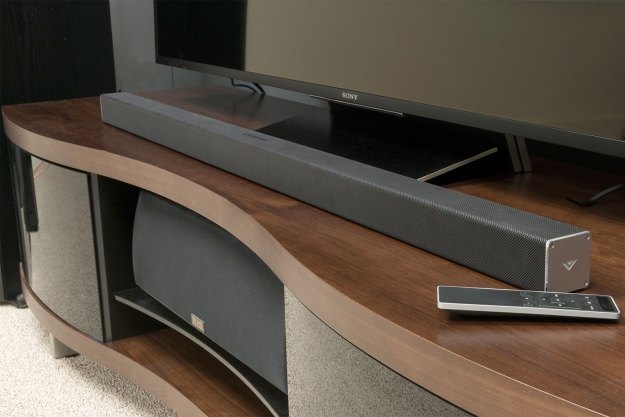
“With SmartCast, Bluetooth, and thrilling 5.1 surround, Vizio’s SB4551-D5 is a huge bargain in a slim package.”
- Powerful, engaging 5.1 surround sound
- Full and punchy bass
- Detailed upper register
- Packed with features
- Highly affordable
- Icy touch to the treble
- Midrange lacks presence
- Interface less than intuitive
As a provider of one of the highest value quotients in the TV marketplace, it wasn’t all that surprising when Vizio stepped into the soundbar game in 2009. Flat-screen TVs and their tiny speakers go hand in hand with soundbars, so why not package them together? What was a bit surprising is how easily Vizio transformed into a quality audio brand, offering the same value proposition in soundbars as its TVs: a whole lot of solid performance at a very low price point.
Vizio’s TV stock has only risen with each new evolution, and 2016 sees the company hoping to do the same with its soundbars. Like its TVs, Vizio’s new SmartCast soundbars are embedded with Google Cast technology for simplified Wi-Fi streaming. The 45-inch SB4551-D5 is the de facto flagship of the new SmartCast fleet, packing true 5.1 surround sound, Wi-Fi streaming, Bluetooth, and a lot more for just $500. The bar itself is really just a longer version of many of its new siblings, all bearing a common trait: they’re super slim. That compromise on real estate equates to a bit a compromise in balance at the middle of the sound, but Vizio’s latest is powerful and full where it needs to be, representing surround sound at a serious value.
Out of the box
Pulling the SB4551 from the box, it really is striking how teensy this bar really is. At 2.1-inches squared, its 45-inch length seems exaggerated as it slides from its sheath like a saber. The tiny satellite speakers nestled beneath are even more striking, looking almost like a pair of floor speakers you’d expect to find in Stuart Little’s living room.
As you’d guess, the subwoofer adds some machismo, and while the whole system looks rather sleek, the sub’s slender aluminum lines and pancake design make it the most attractive part. That’s somewhat ironic, as the small profile is meant to be tucked away under a couch or table, but it also comes with silver feet for mounting on its side. Also in the box is a laundry list of accessories, including extended cables to connect the surrounds to the sub and HDMI, optical, and RCA cables. There are also power cables, mounting brackets, and a slender silver remote with batteries.
System setup
Along with Wi-Fi connection, the bar offers Bluetooth, Ethernet, and hardwired connection via HDMI input and output (with ARC). There’s also analog RCA, analog 3.5mm, optical digital, and even a USB port for flash drive playback, but HDMI should be your first choice. Since the bar packs only one HDMI input, we recommend connecting your most-used component (be it a Blu-ray player or gaming console) directly to the bar, and then connecting the bar to your TV via the HDMI ARC port. This will allow one cable connection to send the highest-quality surround signal from your component, while routing back sound from the TV. The rest of your components will need to connect to your TV directly.
Features and design
While Vizio has gussied up its flagship bar’s exterior design with sleek lines of hard plastic, the big takeaway seems to be an aim for near invisibility. The black bar disappears in the shadows inches beneath your TV, with no concerns about screen blocking. The satellites are so light and svelte they beg to be mounted on your back wall — speaker stands are almost overkill here.
The powerful surround sound invigorates everything from the cheers of a ballgame to Pacific Rim’s raging robot battles.
The smaller profile has forced Vizio to get creative with the drivers inside the main bar: instead of using a stable of smaller drivers, the long bar claims a 4-inch driver each for the right, left, and center channel While it’s not stated in the specs, the laws of physics demand oblong drivers, possibly 4 inches x 1 inch, while the satellite drivers aren’t listed at all. The subwoofer packs an 8-inch down-firing driver hidden beneath a plastic cover on the bottom.
The bar’s blank front face leaves little room for decor, and like all of Vizio’s newer systems, there’s no traditional display. Instead, a sort of shorthand exists between the remote control and a collection of crystal-white LEDs on the left side of the bar. The remote hosts a small LED display, allowing you to rotate through sources, as well as settings like surround volume, bass, treble, and center channel level. In response, the LEDs flash up and down from a center point to represent levels and/or balance.
The system is far from intuitive, so control has also gone digital via the SmartCast app. The app offers fine tuning of the bar, including a full display of all the system settings, Bluetooth pairing, treble and bass levels, etc. While we wouldn’t want to pull out the app each and every time we use the SB4551, it’s a simple way to get settings dialed in for daily listening. Thanks to HDMI connection with ARC, the bar is also able to easily follow most TV remotes for volume and powering on, allowing you to use Vizio’s included remote sparingly.
Pairing nicely with the SB4551’s true surround sound is decoding for Dolby Digital and DTS Studio Sound, along with DTS TruSurround, and DTS TruVolume. Audio can be streamed from any app on your phone via Bluetooth (though pairing is somewhat hidden in the SmartCast app’s input section), but the big ticket item is streaming over Wi-Fi with Smartcast.
SmartCast
Leveraging Google’s casting technology, SmartCast allows easy streaming from virtually any Chromecast-supported audio app you can find — theoretically, anyway. Unfortunately, at present Vizio’s new system is not jibing with Spotify, causing an odd digital distortion during playback. Other apps worked fine, allowing a simple tap of the cast icon from within the app for instant connection to the bar. Vizio claims it is working on a solution with Google for Spotify casting, which will likely be delivered through an automatic firmware update.
Vizio earns props for one of the easiest ways to connect to Wi-Fi streaming this side of Sonos. To connect your bar to your network, simply download the SmartCast app and wait for it to identify your SmartCast device. Once it does, you simply hold your phone next to the corner of the bar and it auto-connects. Along with dozens of supported streaming apps, there are also several internet radio stations loaded right into the app, and you can even add in Google Cast devices, such as the Chromecast Audio or Vizio’s Crave wireless speakers, to create a multiroom sound system. As for Spotify (or any music loaded on your smartphone, for that matter), you’ll need to use Bluetooth.
Performance
The SB4551’s sound signature is a total redesign from the company’s excellent S5451W-C2, no doubt due in part to its ultraslim form factor. While the system offers serious performance for the money, especially for surround sound content, the new design can be a double-edged sword at times.
Details are actually more crisp and better defined at the top of the sound with the SB4551 when compared to its predecessor, which is evident when watching one of our favorite films for sound design, Skyfall. Laser-sharp etchings of subtleties, such as the click of a gun’s hammer or the wispy shuffling of Bond’s jacket in the intro scene, are impressive, offering more presence than we expect at this price point.
In order to get there, though, the system has dredged up an icier touch to the upper register, which can make effects sound a bit prickly, and instruments — especially drums and cymbals — sound synthetic, almost like a drum machine. Dialogue and other fine details in the midrange come off a bit flatter than the topside, creating some mild balance issues in quieter moments. It’s not something that most listeners will pick up on and, at this price point, it’s not something to dwell on, but it may take more discerning listeners a while to adjust.
The icy touch to the upper register can make some effects sound a bit prickly.
However, in more powerful cinematic scenes, this system really proves its mettle — the SB4551 is at its absolute best at full throttle. The satellite speakers do a surprisingly good job of holding their own for their size. While they can sound a little nasally at times, they are well matched to the bar, offering a clear push into that extra sonic dimension to invigorate everything from the cheering crowd of a football game to the raging robot battles of Pacific Rim. The hammer of bass from the subwoofer is well defined, rocking the room in heavier scenes. Slipping the sub under the couch makes for an even more visceral experience; you can actually feel the rumble beneath your seat, which takes the action of explosions, gunshots, and other dramatic moments up a notch. Bombastic scenes really come to life, filling the room with engaging force.
As one might guess, like a lot of soundbars, music is a less thrilling experience. Sound is clear overall, and the system will get the job done, even adding some pleasant virtual surround sound to tracks like Radiohead’s Idioteque. However, the organic flavors of percussion and acoustic instruments are strained, trending more towards that drum machine effect mentioned above.
Our Take
Vizio’s latest sound bar isn’t as smooth as we’d like in the upper register, but buyers will be rewarded with powerful bass, engaging surround sound, and easy access to Wi-Fi streaming at a very nice price point.
What are the alternatives?
If you’re looking for true surround sound, there aren’t many. Vizio essentially owns the 5.1 soundbar segment, so those aiming for a smoother overall sound may want to investigate the aforementioned S5451W-C2. If you’re not dead set on true surround, Yamaha’s YAS-203 is a great all-around bar, with rich mids and ample detail.
How long will it last?
With HDMI, Wi-Fi connection, and a solid manufacturer behind it, Vizio’s SB4551-D5 should last as long as you want it to last. The system’s lack of 4K passthrough, however, means those moving up to a 4K Ultra HD TV will need to bypass the bar and connect their Ultra HD Blu-ray player or new Xbox One straight to the TV, potentially foregoing true 5.1 decoding. Then again, at this price point, those options won’t hamper most potential buyers.
Should you buy it?
Yes. If you’re looking for a highly affordable 5.1 sound solution with plenty of options — and a very small profile — absolutely. Discerning listeners will want to take heed of the tonal shift between the midrange and treble, but this system is powerful and engaging, all at a nice price.












